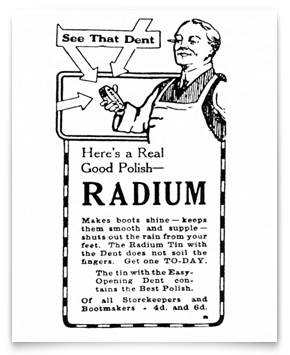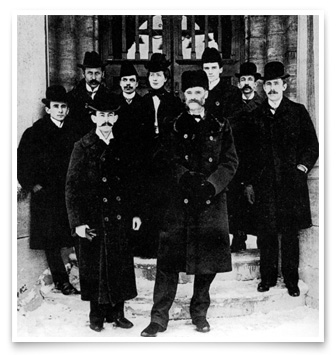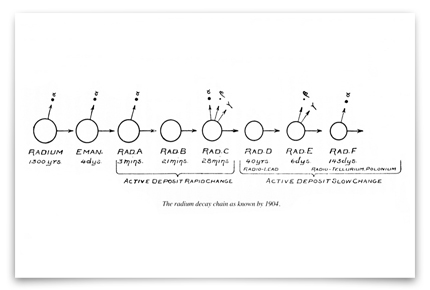Exploring Radioactivity
Rutherford at McGill University, 1898–1907
J.J. Thomson wrote supporting Rutherford for the MacDonald Chair at McGill University:
“I have never had a student with more enthusiasm or ability for original research than Mr Rutherford and I am sure that if elected he would establish a distinguished school of Physics at Montreal.”
 Research Group, Montreal, 1905–6. Top row: G. Dunn, R. Lawrence, Gordon,
Research Group, Montreal, 1905–6. Top row: G. Dunn, R. Lawrence, Gordon,L. Levi, R.W. Boyle. Middle row: R.K. McClung, Otto Hahn, A.S. Eve.
Bottom Row: M. Levin, H.T. Barnes, John Cox, and Ernest Rutherford.
Credit: Chadwick, 1962, 1: opposite p. 832.
Good history of science is written as if looking over the shoulders of researchers as they worked before they had figured out their answers. When Ernest Rutherford accepted the MacDonald Professorship at McGill University in Montreal, Canada, in 1898, little was known about radioactivity or radiation. As he wrote of part of this puzzle: “The cause and origin of the radiations continuously emitted by uranium still remain a mystery.” (Rutherford, 1962, 1:214). Rutherford saw a mystery.
Becquerel had discovered in 1896 that uranium gives off invisible rays that fog photographic film. The Curies had shown that thorium acts similarly. In November 1898, they reported the chemical separation of two unknown materials from the ore pitchblende, both highly radioactive — the first use of the word. André Debierne (1874–1949) discovered another radioactive element, actinium. What they had was unclear, but it was spectacularly unexpected.
The challenge these unexpected phenomena presented had been faced by scientists before. How does one explain something completely new? Isaac Newton (1642–1727) had faced this with light: what is color, what produces fringes of light and shadow at the edges of objects? Michael Faraday (1791–1867) discovered that changes in magnetism produce electrical current and that electromagnetic forces may bend and flex. They investigated these new phenomena by exhaustive experimentation and description. Rutherford's work on radioactivity bears a strong resemblance.
 Radioactivity and x-rays were all the rage around 1900. Radium was a marketing tool and this raised
Radioactivity and x-rays were all the rage around 1900. Radium was a marketing tool and this raisedthe public profile of scientists like Rutherford.
Credit: Campbell, 1999, p. 357.
The method to this experimentation is simple: joyful and inventive play. Think of every tool or technique that might tell us something about the rays given off by radioactive materials. Try them all out. Many will show no result, but some will be revealing. Becquerel found that his rays could pass through thick, opaque materials and that they could ionize gasses so that electrical currents could pass through. He also thought that his rays can be refracted and polarized, similarly to light. Rutherford, however, repeated and perfected these experiments. He detected no refraction or polarization.
Just before he left Cambridge for Montreal in 1898, Rutherford conducted a simple, systematic experiment to study the absorption of rays from uranium. Between a uranium source and an electroscope detector, he placed first one thickness of aluminum foil, then two, and so on up to 13. In each stage, he measured the intensity of the radiation by measuring the time required to discharge the electroscope. He found “at least two distinct types of radiation” which he called α (alpha) and β (beta), “for convenience.” He tested different metallic foils, different radioactive sources, etc. Later, he used other means to manipulate these α and β rays and determined that they were, respectively, positively charged and negatively charged particles. In 1901 he determined that Becquerel's rays are indeed electromagnetic rays. He called them γ (gamma) rays.
 Rutherford’s research students in Montreal, ca. 1899. In the center is Harriet Brooks, one of his first research students. The young man in a bowler hat at the far right is Rutherford. Credit: Rutherford family.
Rutherford’s research students in Montreal, ca. 1899. In the center is Harriet Brooks, one of his first research students. The young man in a bowler hat at the far right is Rutherford. Credit: Rutherford family.
Rutherford demonstrated two important characteristics in his nine years at McGill University. First, he perfected his use of teams of researchers. He had mastered certain kinds of physical lab techniques; he knew that to investigate radioactive materials he needed partners who had mastered chemical lab techniques. His best known chemical colleague was Frederick Soddy (1877–1956), who worked with him on thorium and its decay products in 1901 and 1902. Chemical evidence provided the decisive proof that the change from thorium to the purposefully vaguely named ‘thorium X’ did not occur at the molecular level, but at the atomic level. A new atom was produced, a new element. Rutherford and Soddy concluded: “The idea of the chemical atom in certain cases spontaneously breaking up with the evolution of energy is not of itself contrary to anything that is known of the properties of atoms.” Radioactive decay is transmutation with radiation emitted.  Frederick Soddy ca. 1902.
Frederick Soddy ca. 1902.
Credit: Emilio Segrè Visual Archives (AIP).Together with Soddy, Rutherford firmly established the existence and regularity of radioactive decay. Also at McGill, Rutherford collaborated with the chemists Bertram Boltwood (1870–1927) and Otto Hahn (1879–1968). He followed the lead of J.J. Thomson, too, in effectively directing and collaborating with young research students, such as Harriet Brooks (1876–1933) while at McGill.
The second important characteristic of Rutherford's research at McGill University was his balancing of easy hypothesizing with an absolute reluctance to commit to a conclusion until experimental evidence was indisputable. The α particle provides the best example. Rutherford very carefully established the identity and properties of the α particle between 1898 and 1907. His attempts to deflect α particles with electric fields failed at first, but greater attention to the apparatus led to success. He could show that it was positively charged and he suspected that these particles were doubly ionized helium, that is, the helium nucleus. He refrained from saying this, however, because the challenge of measuring that charge proved insurmountable while he was at McGill. As he wrote to his friend Otto Hahn on 6 January 1907:
 Apparatus used by Rutherford and Soddy in 1902 for measuring the rate
Apparatus used by Rutherford and Soddy in 1902 for measuring the rateof decay of thorium emanation. Credit: Chadwick, 1962,1: opposite p. 480.
“In regard to the alpha particle and helium, etc., and the fitting of atomic weights, I am not worrying about it at present. The whole problem is very mixed. The difficulty lies in the fact that ‘the alpha particle moves in a peculiar way its wonders to perform.’ ...We want a new method of attack.”
(Quoted in Eve, 1939, pp. 153–4)
He found that new method in Manchester in 1908, while working with his student Thomas Royds (1884–1955).
 “The changes of radium as far as they are at present known... further investigation may show that the transformation does not end with radium F.” Credit: Rutherford, Radio-activity, 2nd ed., 1905, p. 404.
“The changes of radium as far as they are at present known... further investigation may show that the transformation does not end with radium F.” Credit: Rutherford, Radio-activity, 2nd ed., 1905, p. 404.
As a result, Rutherford's best known results from his years at McGill University were those contained in his texts Radio-activity (1st ed. 1904, 2nd ed. 1905) and Radioactive Transformations (1906). These secured his reputation and ultimately a Nobel Prize.
Rutherford left McGill University in 1907. Why did he leave good facilities and colleagues? He wrote in that same letter to Hahn:
“I shall be glad to be nearer the scientific centre as I always feel America as well as Canada is on the periphery of the circle.”